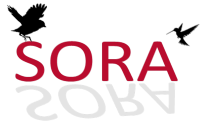Sugar preferences of Black-chinned Hummingbirds at a mega feeding station in Texas
Sugar preferences of Black-chinned Humming- birds at a mega feeding station in Texas.
ROSS DAWKINS, Dept. Chem. & Biochem., Angelo State Univ., San Angelo, TX.
At Dan Brown's ranch near Christoval, TX, approximately 3,000 Black-chinned Hummingbirds regularly feed during the breeding season. Dan feeds more than 800 lb of cane sugar (sucrose) during the year. At this location, we tested various sources and types of sugar and different concentrations of sugar to see if preferences existed. The sugars tested were sucrose from beet sugar (Albertson's Granulated Sugar), cane sugar (Imperial Pure Cane Sugar), fructose (Eastman Organic Chemicals), glucose (Reagent Grade), and high fructose corn syrup (Betty Crocker Corn Syrup). One cane sugar solution was 80.0 ml of deionized water (80.0 g) added to 20 ml of dry, granular sugar (17.7 g sucrose) and this was designated as CS4. A second cane sugar solution was 90.0 ml of deionized water (90.0 g) added to 30 ml (26.5 g sucrose) of cane sugar. This was designated as CS3. The other solutions were like CS4 with 80.0 ml of deionized water added to 17.7 g. of sugar. These solutions were BS (beet sugar), G (glucose), F (fructose), and K (Kara-type high fructose corn syrup). 70.0 ml of each solution were placed in clear, new Perky Pet single port feeders with a bee guard. A six feeder array was assembled in oak (Quercus fusiformis) shade in a 2x3 arrangement. Feeders were 2 m above the ground and 1.5 - 2 m apart. A second six feeder array was set up under the back eaves of Dan's house in a linear arrangement. Again, feeders were 1.5 - 2 m apart. After each sample period, volumes were measured and feeders switched with higher and lower usage feeders exchanged to zero out positional variables. In addition, sampling periods were varied as to time of day from 8 Jul -11 Jul. Dan's normal complement of about 20 two-liter feeders were also available the whole time. Results were tallied by place of finish in each time period. The places of finish were then averaged over the four-day period. The results were fructose (average place 1.7) slightly preferred to beet sugar (average place 1.8). Next were Cane Sugar 3 (CS 3) (average place 2.8) followed by Cane Sugar 4 (CS 4) (average place 3.8). Last were glucose (average place 5) and high fructose corn syrup (average place 5.9). A second method of comparison was by total volume of solution consumed over all trials. Beet sugar was preferred with 177 ml consumed. Next came fructose with 134.5 ml consumed. Cane Sugar 3 (CS 3) with 117.5 ml and Cane Sugar 4 (CS 4) at a 104.5 ml follow. Least preferred were glucose at 36 ml and high fructose corn syrup with only 19 ml consumed. The preference of fructose was surprising in light of other studies that rarely show a preference for fructose. It might be explained by the fact that fructose is about 170% as sweet as sucrose and more than twice as sweet as glucose. Any preference of beet sugar over cane sugar is surprising because both are very pure sucrose with only slight traces of other sugars or salts. If any preference really exists it must be due to trace impurities and their taste. The preference of 3:1 cane sugar over 4:1 cane sugar is expected and has been shown by others. The discrimination against glucose is in accord with some other studies and possibly due to its lack of sweetness. The rejection of high fructose corn syrup is most puzzling, especially in light of the preference for fructose. A second study was done with CS4 solutions. Three feeders had a drop of red food coloring added and three remained colorless. In a second run, all red and colorless solutions were positionally switched. No preference at all was observed.

